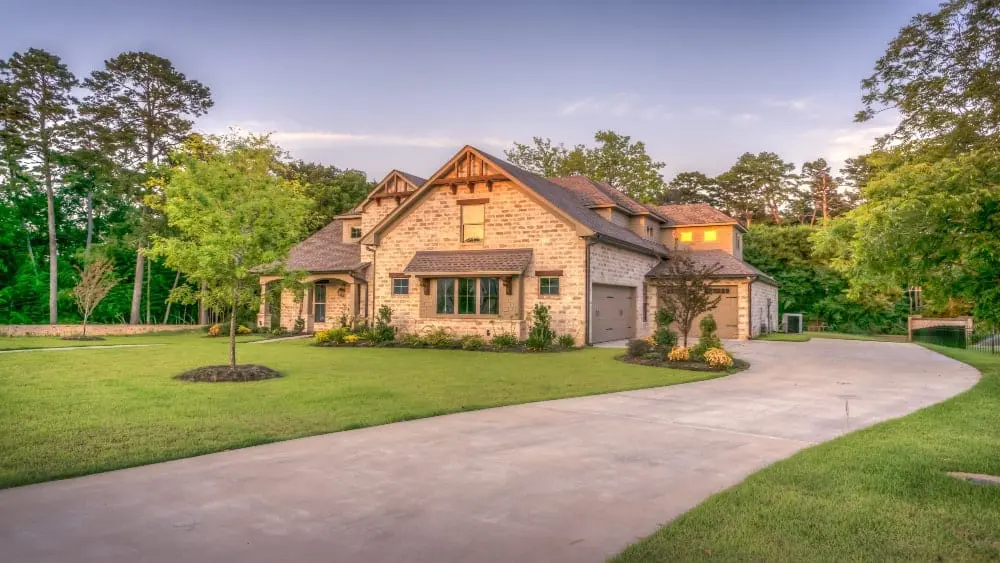
Rolling hillsides and farmlands, spacious gardens with chickens laying eggs, big stately homes steeped in the stories of a family’s generations — this is what often comes to mind when you think of building a home tucked deep in suburbia and the rural parts of America.
The tranquillity, the generous space, the simple life, they’re all incredibly appealing draws for families growing tired of the city’s exhausting hustle and bustle. As you explore developing a home in the countryside, you’ll likely find a growing list of advantages and perks.
If you’re thinking of building a home in the outer suburbs of a major city or in a more rural part of your state, here’s a closer look at nine benefits awaiting you as your construct your dream home in your low-key locale.
1. Space is on your side to build a bigger home.
The United States has plenty of wide-open spaces — rural areas make up 97 percent of the country — but only 22.6 million (19.3 percent) of the country’s occupied housing units are rural, according to the American Community Survey (ACS), conducted by the U.S. Census Bureau. That’s compared to 94.4 million (80.7 percent) in urban areas. So, if you’re feeling cramped in your close city quarters, these stats explain why.
Rural areas offer greater privacy from your neighbors, room to breathe and an expansive property to do as you please, from setting up an outdoor gym to building your own greenhouse or garden. More space means bigger homes too. Your kids won’t have to share a bedroom and there’s room for a home office or space for all of your family’s hobbies.
2. It’s custom-made with your fingerprints all over the design.
Rural homes rarely follow the cutter cookie style of urban neighborhoods. With acres of land to play with, your family and your builder can bring your dream home vision to life.
As it turns out, one of the key defining features of “nonmetropolitan” homes is the high share of custom homes, according to a 2018 National Association of Home Builders report. These homes are either “contractor built,” which means builders were called in to do the job, or “owner built.” In cities, only 16.9 percent of homes were custom-built compared to 52.8 percent of rural homes. The majority of urban homes are built for sale usually in tracts or subdivisions.
With a custom home, your fingerprints are all over the DNA of your property, from deciding on layout and materials to the minute details such as countertops, windows and wall colors. You can build your home to accommodate all family members. You can include an accessible bathroom for older parents or grandparents, or you can soundproof a room for your kids’ music lessons. You can have fun with custom homes too. If your family desires an open-concept kitchen that connects with a beautiful garden for al fresco dinners, it’s all yours. If your kids want a swimming pool and treehouse — well, you’ve got the space for it.
3. The price is right.
Real estate prices will fluctuate depending on where you live, but as a rule of thumb, you’ll get more bang for your buck in rural and suburban America compared to major city centers, where housing and living costs come at a premium. Not only are you gaining access to more space, but you’re also securing this space for less. The price of a shoebox apartment in the center of a major city could get you a four-bedroom house in the suburbs. You can even score a lot more land in the countryside to build as you’d like. With less competition, you won’t have to deal with bidding wars.
The average price of a single-family home built for sale in nonmetropolitan parts of the United States is about $245,552 — 33 percent less than homes in urban areas, according to the NAHB report. On a per square foot basis, suburban and rural homes are 10 percent cheaper. The median price of rural home was $213,000 compared to $324,000 for urban houses.
We also inherently know that cities are more expensive to live in compared to the suburbs and the countryside. A bottle of wine and dinner for two is going to be much less in the suburbs compared to the city. Researchers compared the cost of living for urban and rural families in Pennsylvania and found that those in the countryside paid less for everything — groceries, health care, transportation and, most strikingly, housing, which was 12.7 percent less in rural areas. The financial upkeep is on the rural side too. The disparity in income between rural homeowners and urbanites isn’t much: $52,386 compared to $54,296. But overhead costs for keeping your house going — mortgage payments, utilities, real estate taxes and property insurance — are cheaper for rural homeowners. The median monthly housing cost for rural homeowners paying a mortgage was $1,271 compared to $1,561 in urban areas, according to the ACS data. With incomes nearly on par but cheaper living expenses, rural residents don’t face as much stretch in their budgets.
4. You can add money-saving additions to your build.
When you don’t have to worry about neighbors who are within earshot or sharing a fence, you can make your home self-sufficient in many different ways. You’ll have the space to grow a vegetable garden and tend to your own stock of fresh produce, herbs and flowers. You can even look into raising chickens for a never-ending supply of eggs, or you could add cows, goats and rabbits to the mix.
With your garden in tiptop shape and a few animals grazing, you’ll have a lot of the essentials you’ll need for cooking. Forget waiting for the weekend farmers market — you’re the farmer now, and if you aren’t, one of your neighbors likely will be.
While working with your builder, you can ask about a cold room to keep things refrigerated, as well as a greenhouse to shield your crops from excess heat and cold or unwanted pests. Both of these facilities are electricity-free.
Don’t forget the energy efficiency hacks at your fingertips now that you have the luxury of space to work with. You can look into setting up solar panels, wind turbines and windmills to get your energy covered too. Self-sufficiency means extra savings in your pocket.
5. It’s all yours.
Across the board, families living in rural parts of the country are much more likely to be homeowners compared to their urban counterparts, according to the ACS. Rural areas have a homeownership rate of 81.1 percent compared to 59.8 percent in urban areas. Maybe it’s the cheaper overhead costs of running your home or the cost-efficient lifestyle, but rural homeowners are also more likely to own their homes “free and clear” meaning they’re mortgage-free.
Forty-four percent of rural homeowners paid off their homes compared to 32 percent of urban homeowners. Without a mortgage, rural homeowners end up freeing up a lot of their budget for savings and discretionary spending. And according to the NAHB report, more than 16 percent of single-family homes built in the countryside are paid for in cash compared to less than 9 percent of city homes.
6. Your home is your legacy built to last.
When you’re buying raw land or a prepared lot paired with the opportunity to custom-build your home, your property is likely one for keeps. Not only can you build a larger home for less, but you can also build a multigenerational home or a family estate. This includes guest suites and pool houses that aren’t connected to the main home, separate entrances for privacy and multiple master bedrooms with en suite bathrooms.
By living in a multigenerational home, everyone can contribute to living expenses, young adults can save for their own homes and grandparents can help look after their grandkids while getting the assistance they need too.
7. You’ll have fewer restrictions to deal with.
You’re less likely to run into restrictions on what you can build in rural areas. There may be fewer zoning requirements, permits and limitations on when your builders can work (your neighbors are too far away to complain about the noise). You’ll have more freedom to do what you want with your property, as long as you aren’t breaking state or federal laws. You will, however, need to think about environmental impact assessments on wildlife and water.
Cities can impose limitations on getting heavy-duty vehicles on-site, but this typically isn’t an issue in the countryside. This is a great combination of perks for you and your builder.
8. You can build your own sense of community.
Building a home in the countryside will give you an opportunity to make your positive mark on the community and connect with your neighbors.
While critics may equate the suburbs and rural communities with fewer opportunities and being cut off from certain amenities, this is not necessarily true anymore. A 2019 PricewaterhouseCoopers report found that, in 2016 and 2017, more than 2.6 million people moved from principal cities into the suburbs because of greater affordability.
And once they’re there, “amenity creep” follows, as homeowners demand access to better transit and walkable neighborhoods in proximity to shopping and entertainment. Employment centers start to crop up as residents decide they want to work closer to where they live, according to the PwC report.
While there may not be a Starbucks or McDonald’s at a major intersection, this is a great step for livening up the economic and social aspects of rural and suburban living.
9. You’re leveling up your health and peace of mind.
Science understands what’s enticing you to move to the countryside. The soothing natural landscape right outside your window, fresh air, access to green space — countless studies have pointed to how this picturesque way of living nourishes your mental and physical health.
For example, one study found that taking a walk in nature for about an hour — even just viewing pictures of nature — can help improve memory and attention spans by 20 percent. Another study found that “forest bathing” or taking walks in the countryside comes with a string of health benefits, like lowering your blood pressure and decreasing anxiety. Pretty much the opposite effect of cramming into a packed rush hour subway.
Your sleep won’t be interrupted by the sounds of traffic and sirens, there’s generally far lower crime rates compared to city life, and there’s less pollution and litter.
Building a home in a suburban or rural area can get you out of the rat race and closer to a simpler life, bringing you closer to identifying what’s most important to you and your family.

Carmen Chai is an award-winning Canadian journalist who has lived and reported from major cities such as Vancouver, Toronto, London and Paris. For NewHomeSource, Carmen covers a variety of topics, including insurance, mortgages, and more.
 How to Start Your Own Chicken Coop
How to Start Your Own Chicken Coop
Marie
Hello,
Not sure if this helps but I think this business stole your blog and just rewrote it:
https://diorinteriors.ca/blog/2021/11/05/9-benefits-of-rural-and-suburban-housing/
Jamie Gonzalez
Hi Marie,
Thank you so much for sharing this. We will look into it.